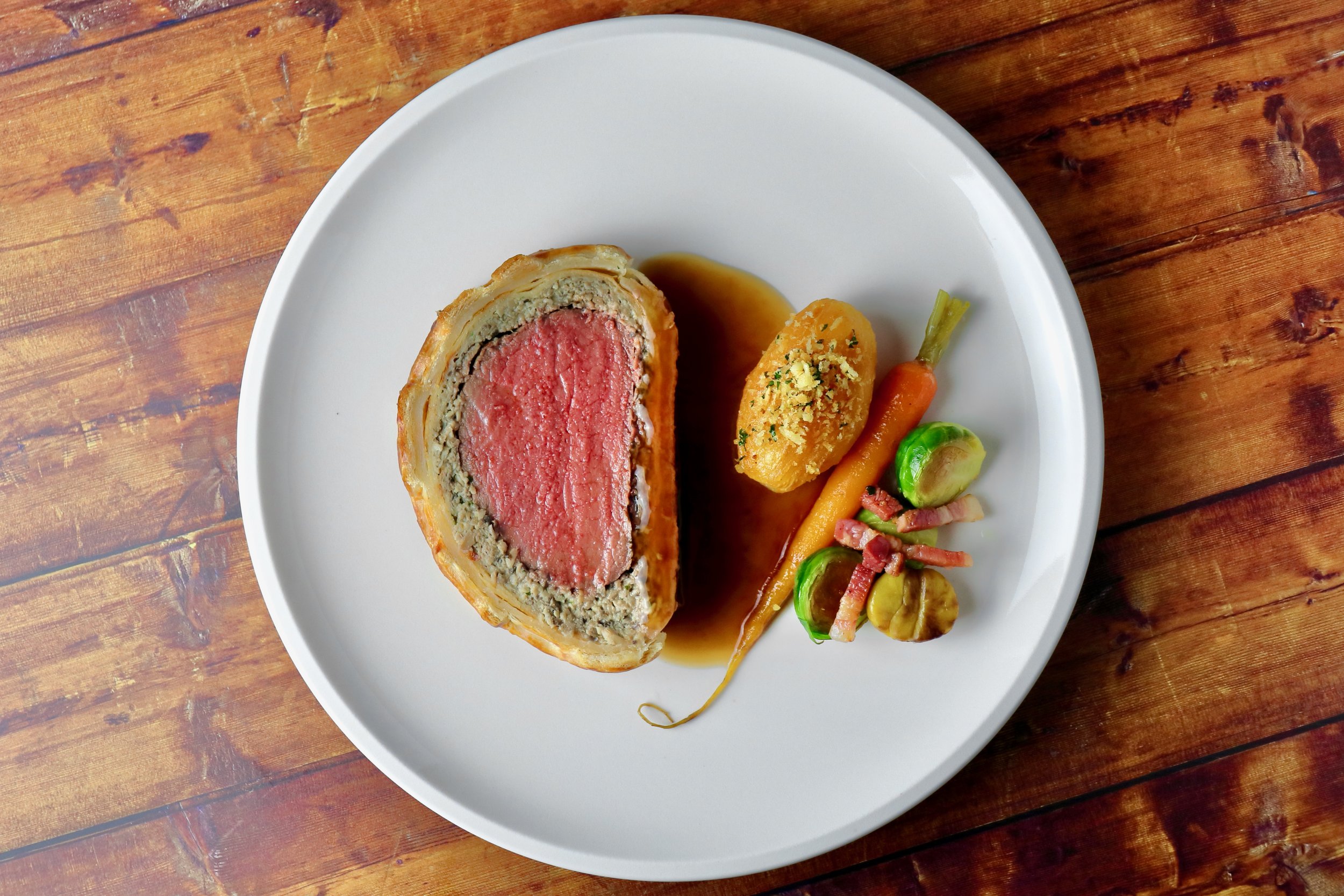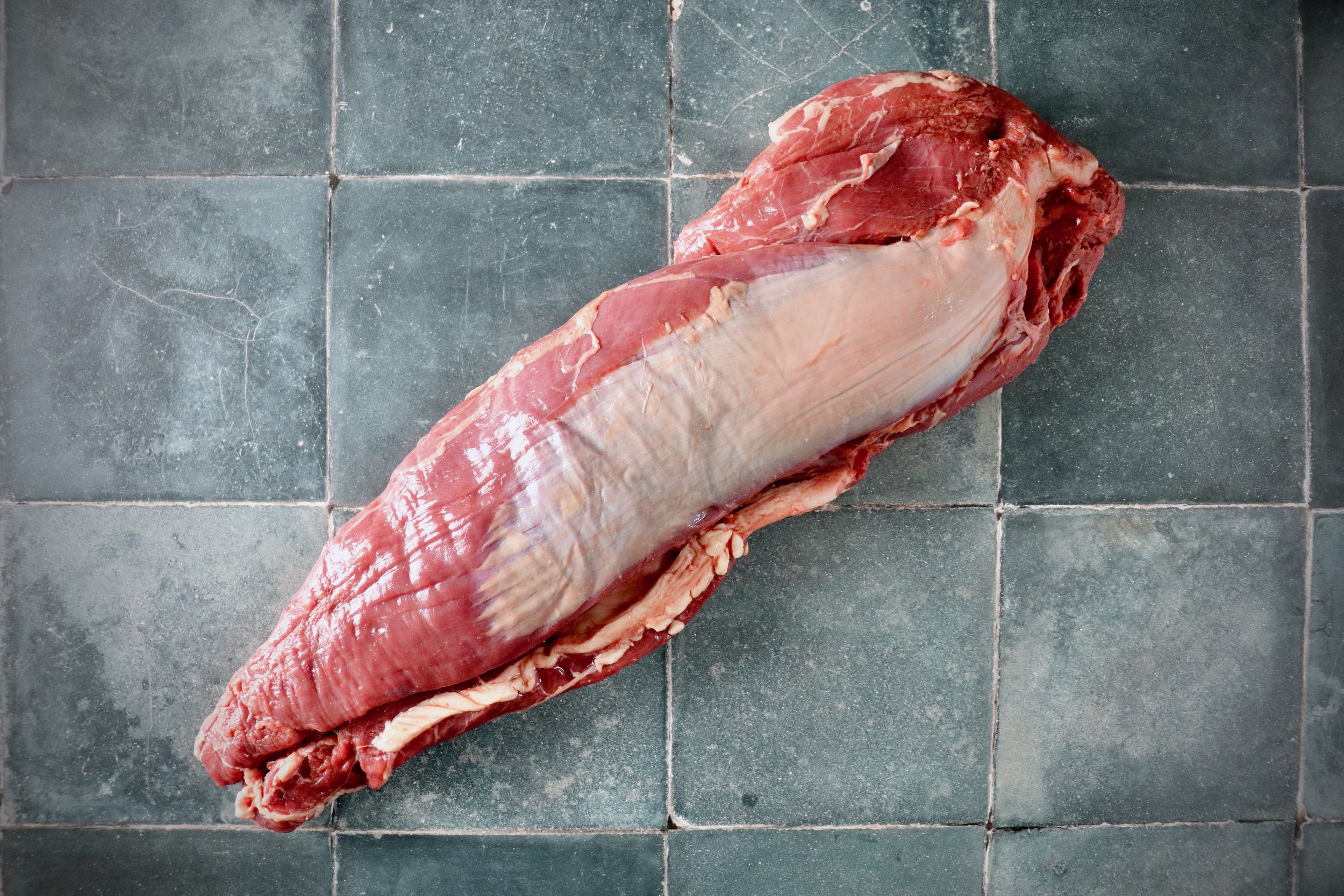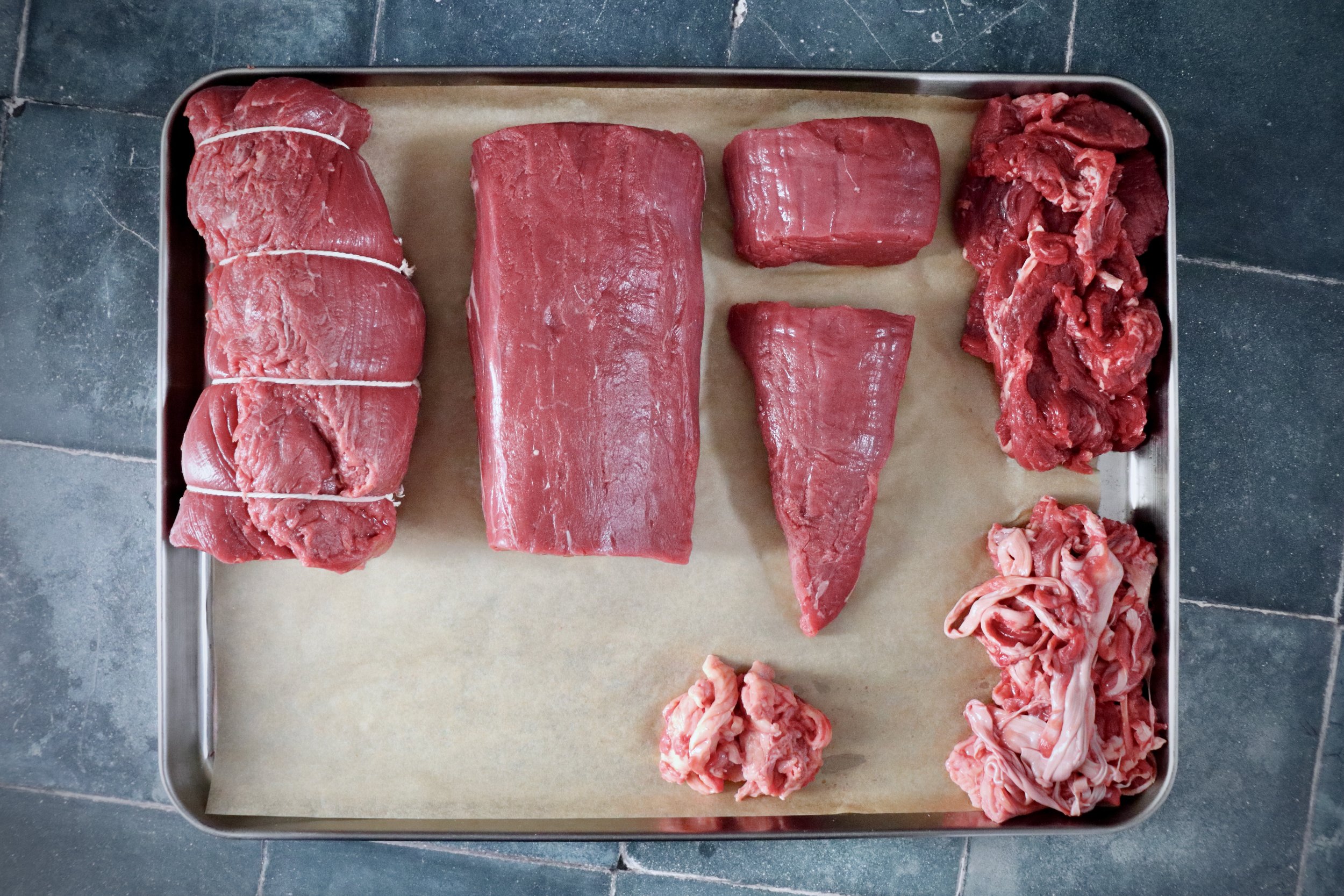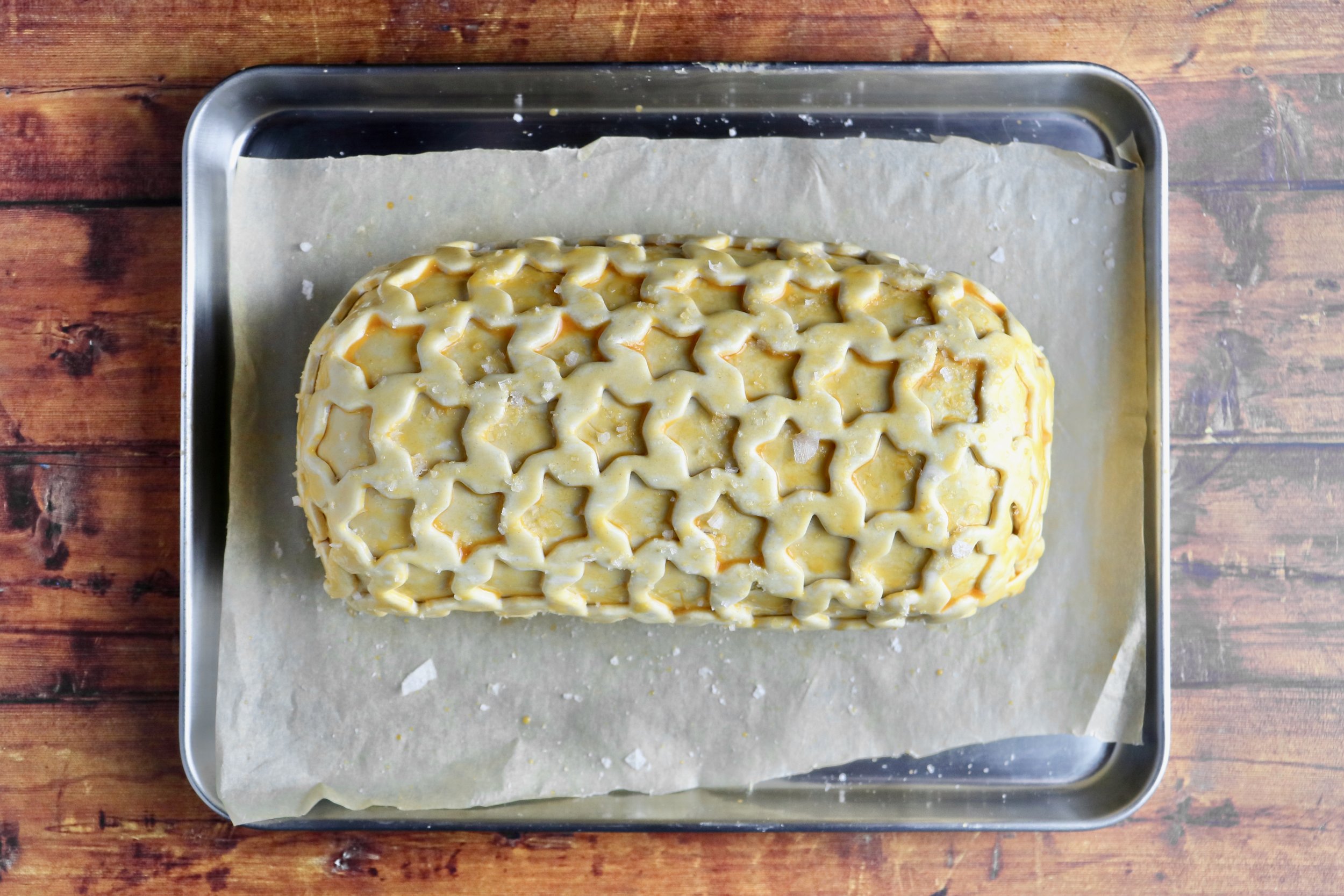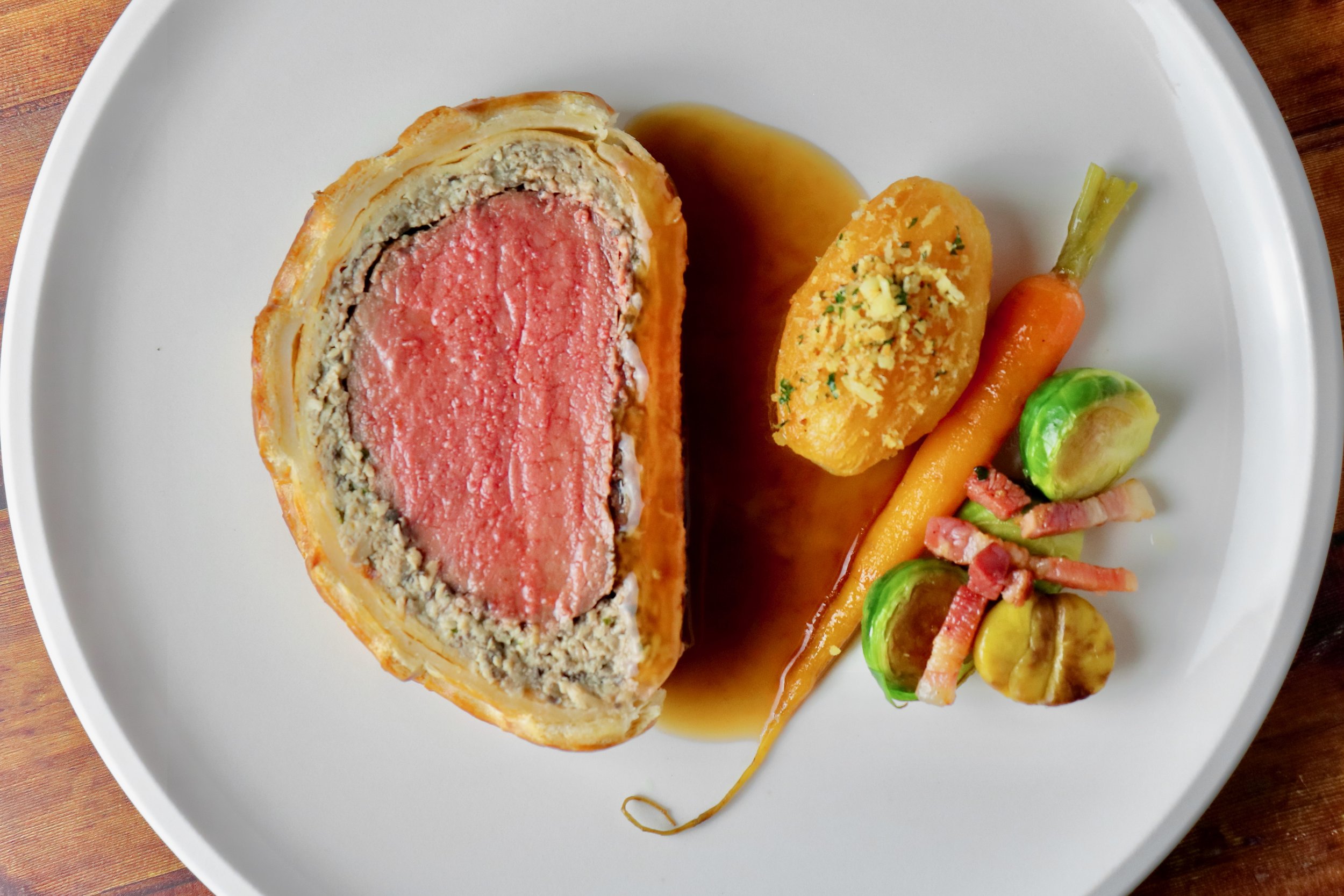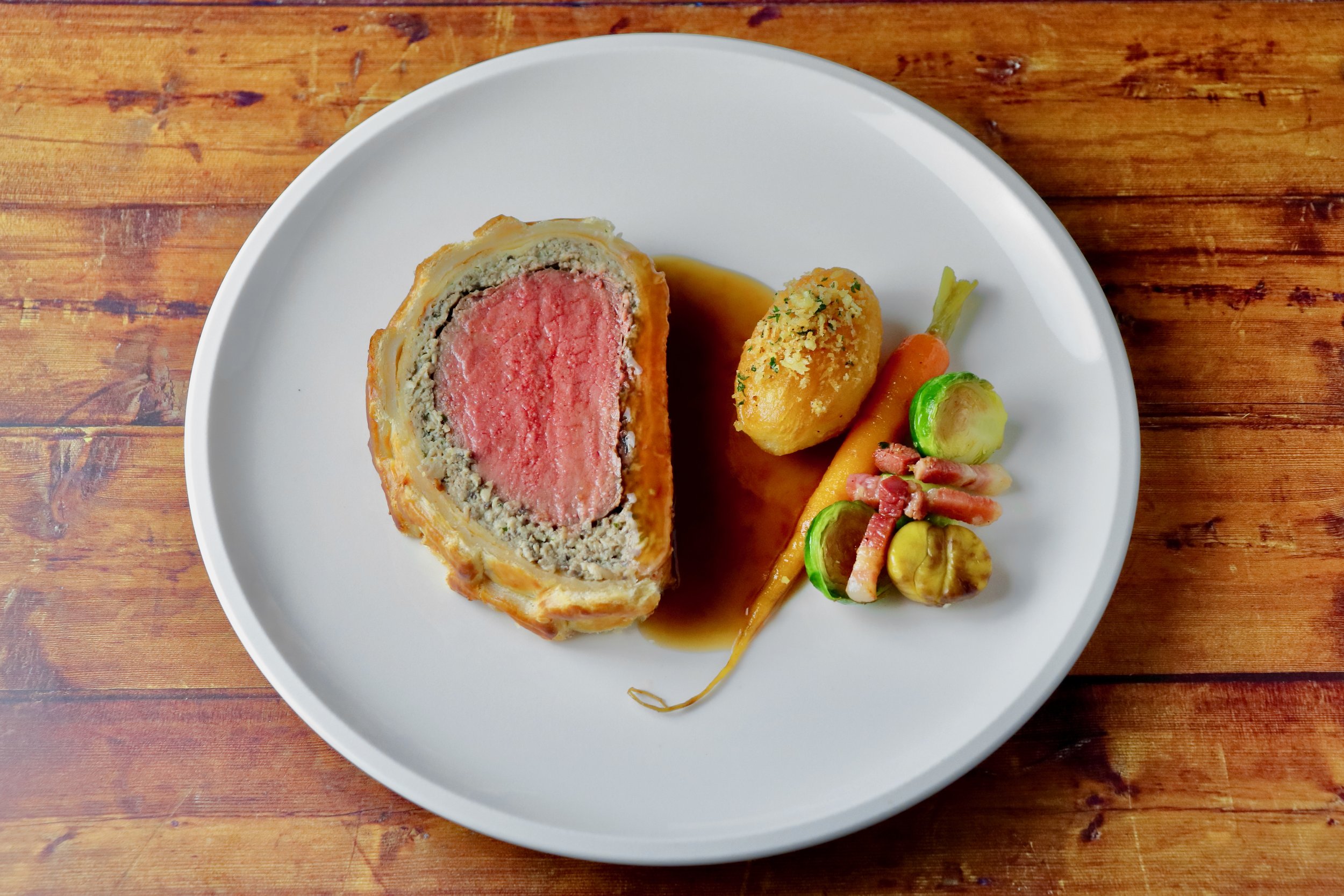Beef Wellington
Beef Wellington. Pomme cocotte roasted in duck fat with pangrattato. Glazed anise carrot. Brussels with chestnuts, lardons and shallot. Beef jus.
Juicy pink beef, wrapped in decadent chicken and mushroom mousse, coated in crispy golden pastry–there are few things as inviting as a freshly baked beef Wellington. This alternative festive centrepiece will blow your dinner guests away.
Ingredients
Feeds 4 to 6.
1 Aberdeen Angus fillet, centre cut weighing approx. 800g
30ml olive oil
2 tbsp Dijon mustard
CHICKEN MOUSSE
200g chicken breast
200ml double cream
1 egg white
MUSHROOM DUXELLES
600g button mushrooms, cleaned
30ml olive oil
40g banana shallot, finely diced
2tbsp chopped parsley
CRÊPES
125g plain flour
300ml whole milk
1 egg
30g unsalted butter
1tbsp chopped chervil or parsley
PUFF PASTRY
1kg puff pastry block
4 eggs yolks for egg wash
JUS
30ml olive oil
500g beef trimmings
50g carrot, roughly chopped
50g onion, roughly chopped
75ml Madeira
1L veal or beef stock; I use TRUEfoods
1 spring of thyme
1 bay leaf
Method
Give yourself plenty of time. And be meticulous. I’ve split the work over 3 days but, if you prefer, you can combine days 1 and 2. Just prepare the beef first thing so the fillet spends as much time as possible in the fridge, tightly wrapped in cling film. Essentially the individual components are made on day 2 and brought together into a beef parcel wrapped in crêpes. The pastry work is left until day 3, that is the day you’ll sit down to eat.
DAY 1
1. Prepare the fillet. Carefully remove the silverskin and any large pieces of unsightly fat.
2. Divide the fillet into 3 sections: the tail, the centre cut, and the Château Briand. The centre cut should have a consistent diameter for even cooking and weigh around 800g, minimum.
Whole beef fillet, untrimmed
Beef fillet broken down into chateâu briand, centre cut, tournedos and tail
3. Reserve the tail and Château Briand for other dishes.
4. Tightly roll the centre cut in cling film to create a cylinder. Tie and reserve in the fridge overnight.
DAY 2
CHICKEN MOUSSE
1. It’s critical that equipment and ingredients be very cold otherwise the mousse can split. Beforehand, chill the food mixer bowl and blade in the fridge or freezer for a few hours.
2. Trim the chicken breast. Remove the skin and any obvious sinews and discard. Chop the breast meat.
3. In the cold mixer, blitz the chicken with the egg white and a generous pinch of salt for a minute. You don’t want the ingredients to warm up by blitzing for too long.
4. Transfer the chicken to a metal or glass bowl sitting over an ice bath. Add just a little of the cream and beat into the chicken with a maryse. Continue adding a little cream at a time and beating, until all the cream has been fully incorporated.
5. Wrap a teaspoon of the mousse in clingfilm and twist tight. Gently poach this in simmering water for 3-5 minutes, until its core temperature is 72C. Check the mousse has set and is not grainy. Taste for seasoning. Add more salt if necessary and test again. Cover and keep chilled in the fridge until required.
MUSHROOM DUXELLES
1. Finely chop the mushrooms to an even size.
2. Heat half the oil in a pan. Sweat the shallot until soft and translucent then transfer to a bowl.
3. Add the remaining oil to the pan and turn up the heat. When the oil is shimmering, add the mushrooms to the pan with a small pinch of salt to encourage them to release their juices. Let the mushrooms get nice and brown to enhance their flavour.
4. Turn the heat down. Add the shallot back to the pan with the mushrooms and cook for 5-10 minutes to dry out the mix. Stir through chopped parsley at the end.
5. Spread onto kitchen paper to absorb any residual moisture, and leave to cool.
CRÊPES
1. Melt the butter to make a Beurre Noisette. Leave to cool.
2. Sieve the flour into a bowl. Add a pinch of salt.
3. In a separate bowl, whisk the egg and half the milk until combined. Gradually add to the flour, whisking continuously.
4. Whisk the Beurre Noisette into the remaining milk. Add to the batter and whisk.
5. Pass through a chinois or fine sieve into a jug. Stir through the chopped herb. Cover with cling film and rest in the fridge for at least 30 minutes.
6. Heat a non-stick frying pan and wipe with a little clarified butter or olive oil.
7. Ladle the crêpe batter into the centre of the pan. Quickly rotate to distribute the batter to the edges and evenly cover the base. You want each crêpe to be as thin as possible.
8. Wait for the colour to change at the edges then turn over.
9. Stack the crêpes between sheets of kitchen paper and leave to cool. Wrap in cling film and reserve in the fridge until required.
BEEF FILLET
1. Unwrap the beef fillet and dry in kitchen paper. Season generously with salt.
2. Over a high temperature, heat a frying pan with the olive oil.
3. When the oil is shimmering, sear the fillet on all sides. Turn every 5 seconds until you have an even, caramelised colour. (You’re not cooking the beef at this point.)
4. Transfer to a wire rack to cool.
5. Brush the beef generously with Dijon mustard.
WELLINGTON PREPARATION 1
1. Thoroughly combine the chicken mousse and mushroom duxelles.
2. Lay a large rectangle of cling film on your work surface measuring 50x35cm. Use 2 layers of cling film. With a tea towel flatten out any air bubbles, starting from the middle and working toward the edges.
3. Working from the edge closest to you, lay out enough crêpes slightly overlapping to create a 35x25cm rectangle.
4. Between sheets of baking parchment, roll the mousse and duxelles mixture into a 30x20cm rectangle with a thickness of 1 cm. Peel the top parchment away and carefully lift and invert to locate the mousse layer onto the crêpes. You want the mousse to touch the bottom edge of the crêpes. Peel away the second parchment.
5. Lay the fillet horizontally across the bottom of the mousse.
6. Using the cling film, roll everything into a tight parcel with the crêpes encasing the mousse and meat. Just before the cling film comes round to meet itself, neatly tuck in the ends of the crêpes ensuring the mousse covers the ends of the fillet. Roll the parcel and tuck the ends of the cling film underneath. It should be air tight and without air bubbles.
7. Lay the parcel on more cling film and roll tightly to form a neat cylinder and centre everything inside. Tie off the ends. Chill in the fridge overnight to set and make it easier to roll into the pastry the next day.
JUS
1. Preheat the oven to 180C.
2. Cut the beef trimmings into small pieces and roast in a pan in the oven for 20-30 minutes, until nice and brown.
3. Pass the roasted trimmings and reserve. Dab the pan with kitchen paper to remove the excess fat.
4. Over a low temperature, add the onion and carrot to the pan. Add a lid and leave to steam for a few minutes to lift the crusty bits from the bottom of the pan.
5. Remove the lid then turn up the heat and caramelise the onion and carrot.
6. Add the beef trimmings back to the pan and deglaze with Madeira. Reduce to a syrupy consistency.
7. Add some of the stock and bring to a simmer.
8. Transfer to a narrow deep pan and add the remaining stock. Bring to a gentle simmer. Skim periodically and reduce by half until the jus covers the back of a spoon.
9. Pass through a damp muslin cloth. Cover and chill overnight.
DAY 3
Work with cold pastry. Cold hands help.
WELLINGTON PREPARATION 2
1. Line a large baking tray with parchment and chill.
2. Make the egg wash. Whisk the 4 yolks with 4 teaspoons of cold water. Pass through a fine sieve.
3. If you’re using a lattice cutter roller, roll out 300g pastry on a lightly floured surface to create a 40x14cm rectangle with a thickness approx. 3mm. Slide the pastry onto the lined tray, cover with cling film and chill in the fridge for at least 30 minutes. (I used a star cutter for a more festive finish and 450g pastry rolled out to a rectangle measuring 40x35cm.)
4. Line another large baking tray with parchment and chill.
5. To encase the beef parcel, roll out 500g pastry on a lightly floured surface to create a 50x35cm rectangle with a thickness approx. 3mm. Dust off any excess flour. Brush lightly all over with egg wash. DO NOT LET THE PASTRY REST AT THIS POINT. TAUTNESS OF THE GLUTENS MEANS THE PASTRY WILL SHRINK TIGHTLY AGAINST THE BEEF PARCEL PROVIDING A NICER CUT-THROUGH.
6. Carefully remove the beef parcel from the cling film. Place it centred against the pastry edge closest to you. Lift the bottom edge of the pastry against the parcel and roll upwards until the parcel is encased in the pastry. As you do this, gently press the pastry against the parcel with the flat of your hand to ensure there are no air bubbles. There should be a 4cm overlap of pastry running directly along the underside of the Wellington. Trim away any excess pastry at the join.
7. Carefully flatten the loose ends of the pastry down onto the work surface, thinning the pastry as much as possible without tearing. Trim the pastry ends leaving just enough to tuck under the Wellington.
Beef Wellington, prepared and ready for the oven
8. Cradling the Wellington at both ends, transfer to the lined tray. Dust off any excess flour. Brush all over with egg wash.
9. Remove the pastry for the lattice from the fridge. Using the lattice cutter roller, firmly roll up the length of the pastry. Use a small knife to work through each cut made by the roller to ensure they open properly when lightly stretched.
10. Turn the tray so that the Wellington is at a right angle to you. Give it an egg wash. Gently stretch the lattice pastry and lay it over the Wellington, stretching it evenly from the middle outwards so that the diamonds form equally. Pat the lattice against the sides of the Wellington, following the form of the cylinder. Tuck all the way underneath to stop the lattice riding up during cooking.
11. Lightly egg wash the lattice. Don’t let the egg wash pool inside the diamonds.
12. Chill in the fridge for 30 minutes. This makes the Wellington as cold as possible when it goes into the oven, giving the pastry more time to cook.
COOK THE WELLINGTON
Beef Wellington, fresh out of the oven
1. Meanwhile, place a tray in the oven and preheat to 200C fan or 220C.
2. Immediately before cooking, remove the Wellington from the fridge and give it final egg wash then sprinkle with sea salt. Again, don’t let the egg wash pool inside the diamonds. Using the parchment paper, lift the Wellington and carefully transfer to the hot tray. This will help avoid a soggy bottom.
3. Place the hot tray back into the oven and bake for 30 minutes.
4. After 30 minutes, turn the tray around inside the oven for an even finish. Bake to the desired core temperature. For medium rare, the core temperature should reach 36C, rising to 45C while resting. For medium, you want 48C rising to 52-55C. Insert a probe into one of the ends of the Wellington, pushing it into the centre of the beef fillet.
5. Transfer the Wellington to a wire rack, allowing air to circulate under the pastry thus preventing a soggy bottom. Rest for at least 30 minutes; longer is better. If you slice the Wellington without sufficient resting, the juices will flood out leaving the meat dry and the pastry soggy.
JUS
1. Take the jus from the fridge and carefully remove any solidified fat.
2. Pass the jus through a fine sieve into a clean saucepan.
3. Gently warm through for 20 minutes, infusing with the thyme and bay leaf.
TO SERVE
1. Use a serrated knife to slice the Wellington.
Fillet of beef wrapped in decadent chicken and mushroom mousse, and crispy puff pastry
Beef Wellington, an alternative Christmas dinner
If you enjoyed this recipe and want to support my cooking, thank you in advance for buying a coffee.
